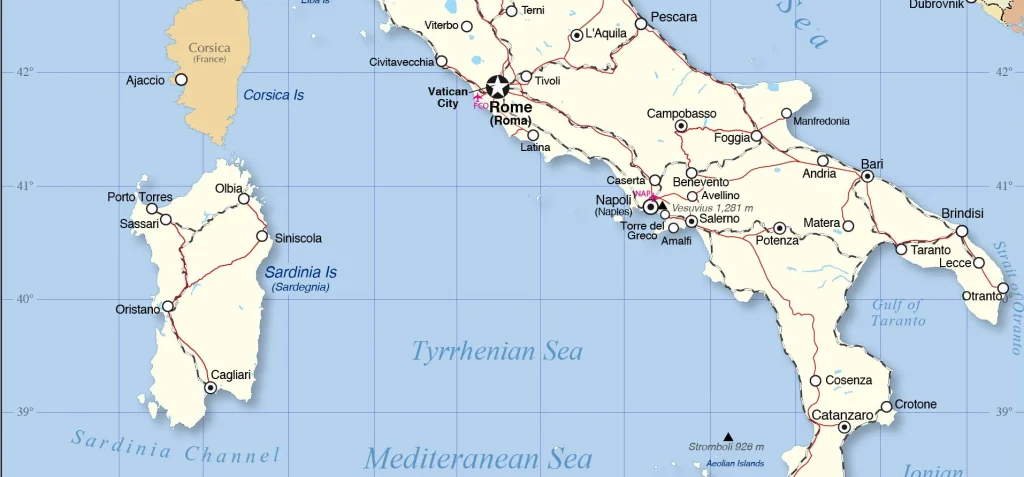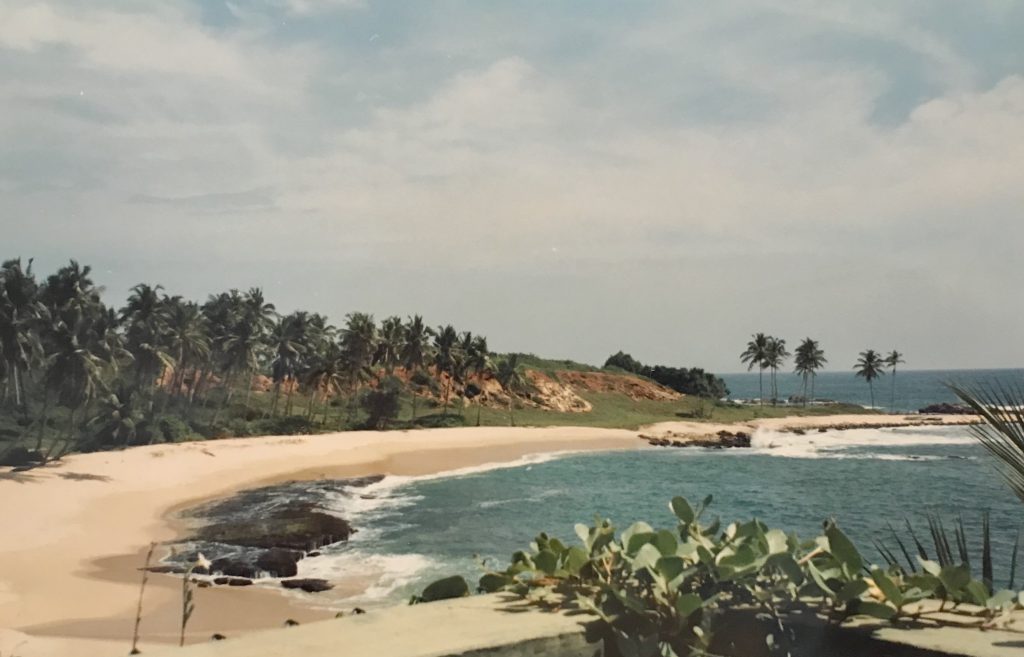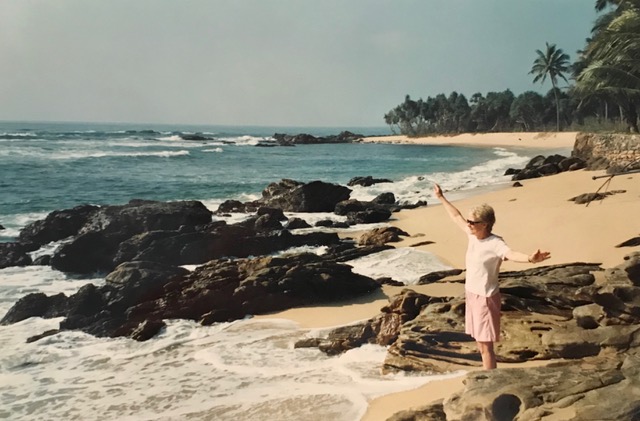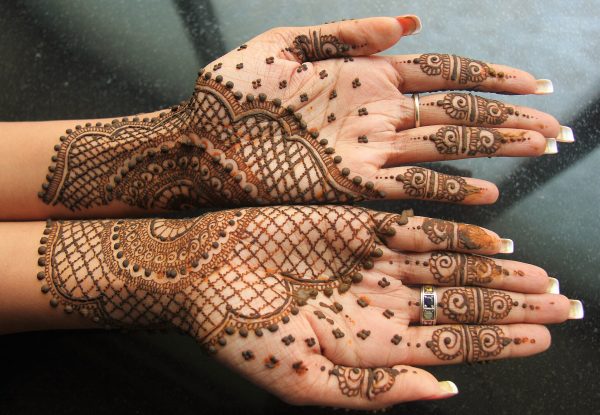#63: USA, Central Italy, Sardinia, Sri Lanka
July – December 2007
To-ing and Fro-ing on Three Continents
On the home front: an injured cat, our first grapes, annual parties with three generations of local friends’ families. Around the world: helping an aunt, celebrating our anniversary in Sardinia, attending a wedding in Sri Lanka. I look back on 2007 now and ask myself how we managed to pack so much into a year. Ah, but I was younger then…
For these and other true stories from our lives in the last six months of 2007, here are edited excerpts from monthly letters to family and friends.
July
A busy month, part of it spent back in the States helping my Dad’s youngest sister identify a northern Virginia senior citizens community where she’d be comfortable. We also helped her with various errands and chores, so it felt like a productive visit.
Before we left for the States, we managed to squeeze in our annual party for the Rosati/Roscini family. We blew up the inflatable pool for the kids, served a lot of cold appetizers, ending up with chicken teriyaki kabobs, salad, fruit and three kinds of dessert. It was a lot of work, but a lot of fun to have everyone back at our house.
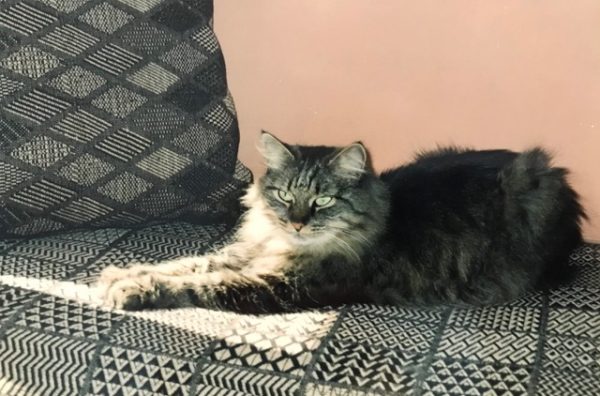 Baby Cat started hobbling, keeping her left forepaw in the air, so off we went to the animal hospital. When the vet turned over her paw, she screamed and struggled. Her third claw had grown into a half-circle and embedded in the pad. When the vet jiggled the claw with tweezers, the entire claw lifted right out, spraying infection. The doc trimmed all 19 remaining claws, while Baby Cat relaxed into the manicure. Some Betadine to cleanse the wound plus antibiotic paste to repel infection, and our girl was back on four feet in 24 hours.
Baby Cat started hobbling, keeping her left forepaw in the air, so off we went to the animal hospital. When the vet turned over her paw, she screamed and struggled. Her third claw had grown into a half-circle and embedded in the pad. When the vet jiggled the claw with tweezers, the entire claw lifted right out, spraying infection. The doc trimmed all 19 remaining claws, while Baby Cat relaxed into the manicure. Some Betadine to cleanse the wound plus antibiotic paste to repel infection, and our girl was back on four feet in 24 hours.
August
We’ve got our first real crop of grapes, started as you may remember from a friend’s cuttings several years ago. Pale yellow bunches hang from the arbor, filling with sweetness and tantalizing us to pick them before they’re ready. In fact, we did pick one, and it was absolutely delicious, even if the seeds were surrounded by only a thin sphere of flesh.
This month’s day trip: In winter, we can look due east from the road linking Montecampano and Fornole to see a double hump of snow that some folks think looks like a crouching beast, hence the mountain’s name, La Leonessa (the lioness). The last Sunday in August was so hot (upwards of 98 degrees Fahrenheit), we decided to visit that mountain. Or at least get as close as we could. We drove up the Terni Valley’s escarpment where the Cascada Marmore was created by the Romans in 270 BC, along the narrow mountain lake of Piedeluca, up and up again until we were well above 3000 feet, through the crest of a pass and down into the alpine bowl which shelters the medieval town, also called Leonessa. The temperature was in the high 70s, vastly more comfortable than where we live at 1000 feet. We walked down the main corso to the fountain-bedecked main piazza, peeked in some old churches and had a nice lunch of local pasta, wine and salad. We returned home via the 6-km tunnel to Spoleto, back through Terni, feeling much refreshed from our day away.
September
The Mediterranean burned this summer, and we witnessed that sad fact as we drove around Sardinia this month — large swathes of blackened earth, some lasting for miles, reaching up to the mountain crests and beyond. Southern Europe’s hottest, driest summer was a major factor in this disaster. What will coming years bring?
Here in Umbria, the grass is tan and sere, the road dust is two inches thick in places, and the fields are slashed by deep fissures. Hunting has been severely curtailed because of the dry conditions. Both olive and grape harvests are suffering, and farmers may face a difficult winter with little to sell.
We went to Sardinia to celebrate our anniversary early in light of Russell’s upcoming trip to Laos in October. Driving down to Civitavecchia (chee-vee-tah-veh-kia), we embarked on the car ferry for the port of Olbia on the island’s NE coast.
The ferry was enormous — 9 decks below the bridge: 4 for cars, trucks and buses; 3 for those who wanted a cabin (most didn’t for such a short voyage); one for bar, restaurant, kiddy play area, shop and glassed-in enclosures at either end; and an open deck on top where we could lounge protected by a glass barrier against the wind or brave the breezes in an open area. During the high season, it must carry hundreds of passengers. We certainly had scores and scores of them.
We left at 3:00 pm and arrived after dark at 8:30, the lights twinkling all around as we sailed into the large harbor. We’d reserved a room for one night in Olbia, and luckily we could see our hotel’s green neon sign not far from the end of the quay. A good sleep, a visit to the generous breakfast buffet, and we were on our way north to the Emerald Coast
And disappointment. We’ve heard for decades about this series of resorts developed in the Sixties by the young Aga Khan (not the naughty playboy but the responsible one only a few years older than us). Many of our Italian friends have vacationed there, and the “Beautiful People” still arrive in summer to see and be seen. But we found it over-hyped and over-priced, the legendary architecture looking a bit dated and the shops nothing different from what you might find in any good mall.
Never mind, we hadn’t expected much, given our own preferences. So after a look around to ensure we’d really seen it plus a cappuccino and pastry apiece, we were on our way across the island through high mountain valleys spangled with ancient Romanesque churches. We ended the day at the port of Alghero (pronounced with a hard ‘g’, as in ‘spaghetti’), founded by Genoese nobility in the 12th century and conquered by the Aragonese in 1353. So pervasive was this Spanish influence that many elderly people still speak Catalan (despite modern Italy being founded over 150 years ago).
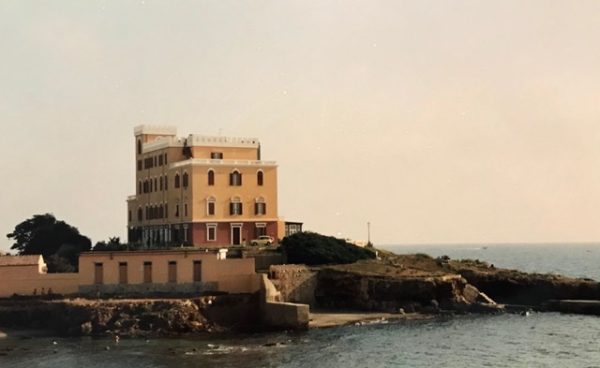 We stayed two nights in an Italian noble’s former hunting lodge, later the family’s seaside villa, now converted into a small hotel. Once a half-mile outside the old walled town, it sits on its own 15-acre peninsula jutting into the sea, the surrounding countryside now filled with hotels and vacation rentals.
We stayed two nights in an Italian noble’s former hunting lodge, later the family’s seaside villa, now converted into a small hotel. Once a half-mile outside the old walled town, it sits on its own 15-acre peninsula jutting into the sea, the surrounding countryside now filled with hotels and vacation rentals.
We walked all over the medieval/renaissance city, enjoyed some delicious meals and bought the celebrated torrone (nougat with toasted almonds) as gifts for Amelia friends.
Then it was down a spectacular coast reminiscent of Big Sur to Oristano (oh-ris-tah-no), a mostly modern town that is the gateway to the ruins of Tharros (tah-ros). Founded on a narrow peninsula by the Phoenicians at the end of the 8th century BC, Tharros is one of the most ancient sites in the Mediterranean. There is evidence on the hill above of an even older Bronze Age village, but most of the visible remains are from the Punic-Roman era. The village/town/city evolved for 2500 years until abandoned in 1070 AD because of recurring pirate raids. The citizens moved further along the bay, carrying with them stones and columns to found Oristano.
Unfortunately, most of old Oristano no longer stands, and one has to wander through winding streets to find evidence of the enlightened rule of Mariano IV and his daughter, Eleonora. This lady was fabulously ahead of her time, promulgating laws giving rights to citizens that wouldn’t be matched for centuries.
Nearby, we visited the wonderful small museum of Cabras with its excellent collection and depictions of what life was like in ancient Tharros. And we came upon the 4th century AD Basilica of San Giovanni di Sinis. Visiting this almost tomb-like church from the paleo-Christian era was surely one of the highlights of the whole trip.
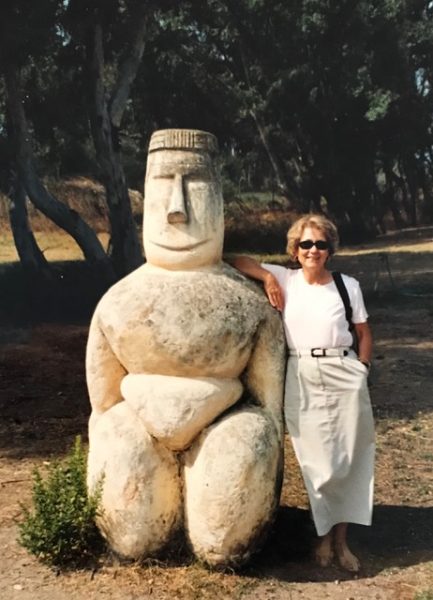 En route from Oristano to Cagliari (ka-lee-ah-ree), we took a side trip to Su Nuraxi, the best preserved of the hundreds of prehistoric sites in Sardinia. You may remember seeing the typical tiny figures of the culture’s Mother Goddess in the National Geographic, etc. (Enclosed is a photo of a greatly enlarged version at the Museum; hopefully you can tell which female is the Goddess.) Dating from 1500 BC, Su Nuraxi was built of giant, irregular stones without mortar, just like Amelia’s walls. A great deal of the Su Nuraxi fortress still stands, and we were able to climb to the top, then down inside the keep, originally 62 feet high, its massive interior supported by corbelled vaults.
En route from Oristano to Cagliari (ka-lee-ah-ree), we took a side trip to Su Nuraxi, the best preserved of the hundreds of prehistoric sites in Sardinia. You may remember seeing the typical tiny figures of the culture’s Mother Goddess in the National Geographic, etc. (Enclosed is a photo of a greatly enlarged version at the Museum; hopefully you can tell which female is the Goddess.) Dating from 1500 BC, Su Nuraxi was built of giant, irregular stones without mortar, just like Amelia’s walls. A great deal of the Su Nuraxi fortress still stands, and we were able to climb to the top, then down inside the keep, originally 62 feet high, its massive interior supported by corbelled vaults.
On to Cagliari, the capital of the island with its ancient walled castello, modern museums built into the old arsenal, and a spectacular early 20th century conversion of an old bastion into a piazza with wonderful views of the enormous harbor and modern city below. We particularly enjoyed the archeological museum with the best collection of finds from the sites and cities we’d visited (LOTS of Mother Goddesses, as well as lovely jewelry, bronze figures, masks and weaponry from all eras).
We’d been so busy, seen and experienced so much, that it almost came as a surprise when our last full day called us to drive back to Olbia, stopping off in San Teodoro for lunch and a walk on the beach. We found this unpretentious little seaside town far more agreeable than where we’d started our Sardinian sojourn. After another night in our green-signed hotel, we were up early to catch the morning ferry back to the mainland.
For me, perhaps the finest experience of the whole trip was reading and dozing on the upper deck of the ferry, caressed by gentle breezes and wondering if this is what it must have been like in the days of the great ocean liners. The whole thing was so soothing, it’s no wonder doctors used to prescribe an ocean voyage for all sorts of ailments.
Two other items of note this month:
- We held our annual party for the Galinella/Gubbiotti family on the 9th. Lots of fun with the usual treasure hunt, but also with play-items I’d bought in Scotland and saved for the occasion.
- All of Italy went into deep mourning when the tenor Luciano Pavarotti lost his battle with pancreatic cancer. I, too, felt the loss, remembering the days of 1991 spent packing up our Virginia house in preparation for joining Russell in Laos, all the while listening to the Three Tenors’ original concert at the Baths of Caracalla. The greatest voice of our age, stilled.
October
Early in the month, we went by train to Florence to take in an exhibition at the Pitti Palace’s 18th century Lemon House (where the noble family grew citrus trees in winter). “The Ancient Garden from Babylon to Rome” used old texts (the Bible), art (frescoes), artifacts (statues), models (giant screws to lift water up to the “hanging” gardens) and full-scale depictions to show how our ancestors conceived, built and maintained gardens. Among the most intriguing aspects of the exhibition were the hydraulic systems that kept gardens alive in the relatively dry Mediterranean climate — all sorts of pipes, fountains, canals and pools, even bronze birds made to sing by water pressure.
Everyone here is quite pleased about Al Gore winning the Nobel Peace Prize. Europeans in general are much more concerned about the environment and global warming than surveys show Americans to be. Europeans feel it is the most important crisis facing us today (along with war in the Middle East).
Now busy with the second draft of my second book, using feedback from readers of the first manuscript. I’m making major changes in the plot line, because of the feedback’s consensus that using child porn as the #1 crime is likely to make publishers nervous. Amazing when today’s news is full of what these twisted people are doing. So now it’s a minor theme — I want to show that even “nice” people are involved — and the #1 villains are doing something else.
Russell left for Laos on the 24th to present his proposal for strengthening provincial entrepreneurs, creating skill-building centers with foreign-investor support. The U.N. Development Program is funding this effort to bring energy to a flagging program.
We realized that Russell wouldn’t return from Laos by Halloween, so we had him dress up in a trench coat, fedora and sun glasses for a photo opp. I wore a similar outfit on Halloween and made the rounds of our friends’ houses. When I pulled out his photo and asked everyone if they’d seen this man, they joined in the charade, saying yes, but he was far away now…
November
When I picked up Russell at the airport after his Laos project, the news was that his proposal had been accepted, so our main topic of conversation was what to do if we move to Vientiane. Among the challenges: what to do with elderly pets, our house (Rent it? Keep it for our vacations? Let friends use it for their vacations?), gardens and olives. Or should Nancy stay in Italy, as she did when Russell worked in Sri Lanka, keeping pets, house, etc. functional? Truly a quandary.
Then came a rollercoaster, as UNDP put his proposal on hold as they tried to figure out how to procure this new type of private-public partnership under traditional rules of project administration. Meanwhile another UN agency got in touch to ask Russell to analyze how Croatia and Mozambique had been so successful in attracting foreign investment and to write their case studies.
So while everything’s up in the air, we’ve decided to accept an invitation from dear Sri Lankan friends to attend their daughter’s wedding in Colombo over the Christmas holidays. Why wait around while the United Nations tries to get their act together when you can be walking barefoot on the beach in your silks and satins??
December
Our two weeks in Sri Lanka were full of seeing old friends, traveling some, shopping a bit and of course, attending the three-day wedding ceremonies. A real highlight of the trip was finding how pleased everyone was to see Russell, whether former project staff members, friends, hotel personnel, drivers or colleagues.
Before the scheduled ceremonies, we relaxed at the beach hotel where we were when the tsunami struck. Russell’s old driver, Kumar, took us to the nearly empty hotel at what should have been the height of the season. Business had never picked up after the tsunami, partly due to the disaster, but also because of the return to civil war with travelers’ advisories issued by many Western governments. Two photos enclosed, one showing the bay which filled to 20 feet above sea level and another when, on the morning of December 26th, at 9 a.m., exactly the date and hour that the tsunami had struck, we went down to the sea to cast flowers on the waves in memory of all those who had perished and in thanksgiving for our delivery. It was very moving, bringing closure to our experience of that terrible event three years ago. (See Blog #56.)
We returned to Colombo in time for the Mehndi, painting the bride’s hands and arms in intricate designs with henna. Many of the guests and all female family members had less elaborate designs made by women trained to perform this service. I confess that although I’ve been to several South Asian weddings where this is always a feature, I’ve never had it done. I’m not a fan of how it looks, and it doesn’t wash away — you have to wait for the layers of skin cells to slough off. Luckily, I wasn’t the only woman who didn’t offer up her hands to the henna-painters, so I think my reluctance went unnoticed.
Other highlights of the evening:
- The bride’s family home is typical of upper-class Columbo houses. A double gate leads through a wall into a garden with an open-air room at the front of the house. One then treks through several rooms to a large, enclosed space within the house, open to the sky. The house was decorated with festooned saris swooping here and there, a mandala made of flower petals on the floor, fairy lights, flowers, tea lights and oil lamps lighting pathways.
- The bride, dressed in a red sari, was brought into the central garden by her female relatives and friends, lots of noise and jolly joshing all around. She was seated on a dais, and then the groom, dressed in silk tunic and turban, was escorted by his male relatives and friends. More noise and joshing.
- The groom is English, and he, his relatives and English friends were all very good sports about wearing SL traditional dress and observing local customs. This was rather easy in that the bride’s family is quite cosmopolitan, treating the Mehndi as a fond observance of tradition rather than a strict adherence to ritual.
The next day, we foreign guests were taken by bus to Bentota, a beach community to the south where the bride’s family owns property. That night, the foreigners were treated to a barbecue by the hotel pool, featuring the best grilled prawns I ever ate. We enjoyed meeting folks who’d come from Houston, Arlington, Sydney, London and elsewhere to help Leah and Lee celebrate.
The actual wedding was on the third day, a Christian ceremony on the beach, framed by giant rocks as the sun set. The bride and groom were dressed in typical Western fashion. The Sri Lankan guests were dressed to the nines in gold-trimmed saris or silk trousers-and-tunics for the women, dark suits or long tunics and trousers for the men. Many of the foreign guests were underdressed, despite the invitation indicating “formal/semi-formal.” Russell was complimented for his suit-and-tie, and I got admiring looks from the ladies for my long silk skirt with wide bands of tobacco, gold and vermillion. So we must have hit the right note.
The ceremony was followed by cocktails and canapés, then by an elaborate buffet supper for 200 under a white marquee. The celebration ended with fireworks and a disco under the stars. Festivities went on until 4 a.m., but we old folks left well before midnight.
The only thing that marred these festivities was the assassination of Benazir Bhutto. The bride’s father had gone to Oxford with Benazir. She’d been invited to the wedding but declined, because she was campaigning for the Pakistani presidency. She was killed just as the Mehndi started, and Zarook was clearly putting on a brave face to cover the distraught one hidden below.
It also felt like a loss to me. I was working in Pakistan when Benazir returned from exile the first time to campaign (successfully) for prime minister. I remember the joyous crowds and the sense that finally the country might get on a productive track. History was to decide otherwise, but for one brief, shining moment, Pakistan had a touch of Camelot.

COMING NEXT MONTH
#64: Italy, USA, Geneva and Back to the USA
January – June, 2008
A Time of Transitions — Death, Confirmation, Reunion and Respite

LET ME HEAR FROM YOU.
Please take a moment to share your thoughts.
Your comments help make the blog better, and I always answer.
* * *
If you enjoyed reading this post, I hope you’ll SUBSCRIBE by clicking on the button below. Every month, when I post a new excerpt from my life overseas, you’ll get an email with a link so you can read the next installment. Subscription is free, and I won’t share your contact information with anyone else. Your subscribing lets me know you’re reading what I write, and that means a lot.

